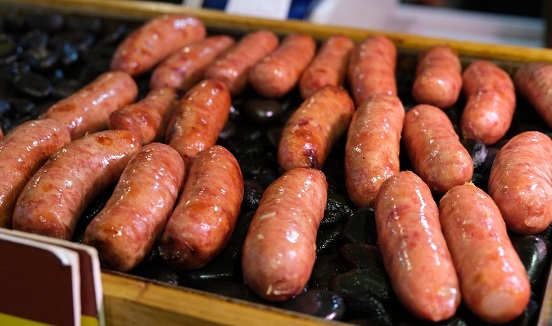
Short, thin, and bursting with flavor, the Nürnberger Rostbratwurst may look modest, but it’s a true heavyweight in German sausage culture. Protected by EU law and rooted in over 700 years of culinary tradition, this little sausage is one of the most distinctive and beloved foods of Franconia, a region in northern Bavaria.
Served grilled over an open flame (“Rost” means grill), these sausages are typically enjoyed by the dozen, with sauerkraut or potato salad. In this article, we’ll explore the history of Nürnberger Rostbratwurst, show you how to make them at home, and explain the best ways to serve and enjoy them.
A Brief History of Nürnberger Rostbratwurst
The earliest known mention of this sausage dates back to 1313 in the city of Nuremberg, and the recipe has hardly changed since. Back then, the small size was partly due to high meat prices and the city’s strict sausage regulations.
Today, Nürnberger Rostbratwurst is protected by PGI (Protected Geographical Indication) status under the EU – meaning only sausages made in Nuremberg following traditional methods can bear the name.
They are characterized by:
- A weight of about 20–25g per sausage
- A length of 7–9 cm (about 3.5 inches)
- A natural sheep casing
- A coarse-ground pork filling seasoned with marjoram, pepper, and nutmeg
Ingredients for Traditional Nürnberger Rostbratwurst
This recipe makes approximately 30 small sausages.
Ingredients:
- 1 kg pork shoulder, trimmed but well-marbled
- 200 g pork back fat
- 2 tsp salt
- 1 tsp white pepper
- 1/2 tsp marjoram (essential)
- 1/4 tsp ground mace or nutmeg
- Optional: pinch of lemon zest
- Crushed ice or cold water (about 100 ml)
- Sheep casings, soaked and rinsed
Tools and Equipment
- Meat grinder (coarse plate)
- Stand mixer or bowl
- Sausage stuffer
- Digital scale (for precision)
- Grill or grill pan
- Casings pricker (optional)
Step-by-Step Instructions
Step 1: Grind the Meat
Chill all meat and fat until firm. Grind once through a coarse plate. Chill again briefly.
Step 2: Season and Mix
Combine meat with salt, pepper, marjoram, and mace. Add crushed ice or cold water and mix thoroughly until the mixture becomes sticky and binds well.
This mixing step is crucial for the springy texture of the final sausage.
Step 3: Stuff the Casings
Using a sausage stuffer, fill sheep casings and twist into 8–9 cm links. Each sausage should weigh around 25g.
Be gentle to avoid tearing the delicate casings. Prick air bubbles with a sterilized pin if needed.
Step 4: Rest or Freeze
Refrigerate the sausages uncovered for 12–24 hours before grilling. Alternatively, freeze in portions for future use.
Step 5: Grill and Serve
Grill over medium-high heat for 8–10 minutes, turning occasionally until browned and cooked through.
Avoid boiling or frying – grilling is traditional and enhances flavor.
How to Serve Nürnberger Rostbratwurst
These sausages are best served in multiples of three. In Nuremberg, they are famously served:
- Three in a bun (Drei im Weggla) with mustard
- On a plate of six, nine, or twelve with sauerkraut or potato salad
- Accompanied by a cold Franconian beer
Classic Side Dishes:
- German potato salad (vinegar-based)
- Horseradish and sauerkraut
- Rye bread with mustard
(For more, see German Potato Salad Recipes.)
Variations and Notes
- Veal blend: Some recipes use a small amount of veal for a lighter color and flavor.
- Smoked version: Though not traditional, a light cold smoke can be applied before grilling for extra aroma.
- No grill? A cast iron skillet on high heat works well for getting that charred crust.
Storage and Reheating
- Raw sausages: Keep refrigerated for 2–3 days or freeze for up to 3 months
- Cooked sausages: Store in an airtight container in the fridge for up to 4 days
To reheat, gently warm in a pan or oven – avoid microwaving to preserve texture.
Fun Facts About Nürnberger Rostbratwurst
- Over 3 million sausages are produced every week in Nuremberg.
- They’re so iconic that local regulations govern their size and seasoning.
- A Nuremberg sausage museum inside the city walls celebrates its history.
- In the Middle Ages, the small size allowed them to be passed through tavern keyholes after curfew.
The Nürnberger Rostbratwurst is a true symbol of Nuremberg’s culinary pride – small in size but packed with history and flavor. Whether grilled over charcoal or sizzled in a cast iron pan, these sausages deliver pure, old-world satisfaction.
Once you’ve tried them three at a time, as tradition dictates, you may never look at “just a sausage” the same way again.
Ready for more regional sausage traditions? Explore our Weisswurst Recipe for a taste of Bavaria or try making Currywurst to sample Berlin’s favorite snack.
